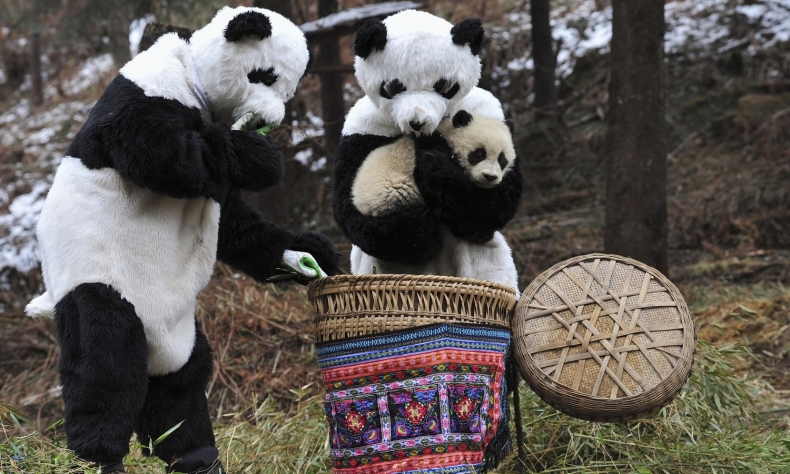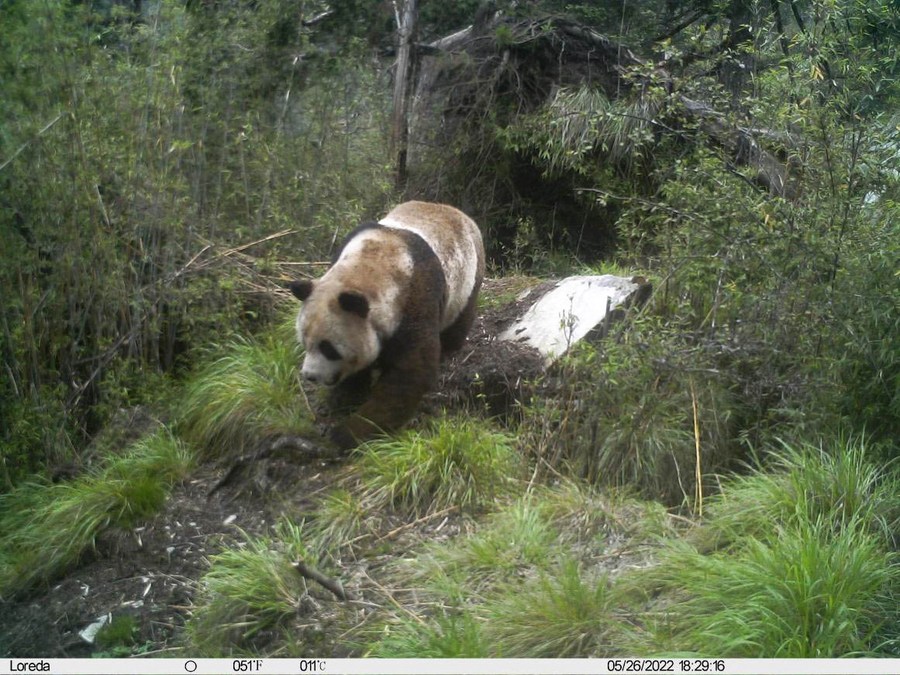Lessons from Baoxing

These fluffy and playful bears have warmed the hearts of people around the world, inspired wildlife conservation, and strengthened foreign diplomacy.
In the heart of Sichuan Province in southwest China lies a small county not many people know about, though the fluffy animals first discovered there scientifically are universally known and adored. Baoxing in Ya’an City is better known as the hometown of China’s giant pandas and today, it has also become a biodiversity hotspot and type locality for many endangered species.
The region has witnessed China’s journey in discovering, appreciating, and protecting wildlife. On April 22, a group of foreigners together with Chinese scholars, government officials, and panda lovers gathered in Baoxing to celebrate the 155th year of the scientific discovery of the giant panda and the 60th anniversary of the establishment of diplomatic relations between China and France. The giant panda origin tracing tour included the inauguration of the Giant Panda International Culture Exchange Center in Baoxing and a series of activities at the Panda International Original Discovery Camp, including a tour of the site where a French zoologist recorded the giant panda 155 years ago, the first Westerner to do so. There was also a dialogue between Chinese scholars and international young people, and a visit to the four pandas living in the camp area.
During an age of challenging political changes across the world, hegemony of political parties, and conflicts between political systems, what inspiration can the story of the discovery of giant panda give us today?
Inspiring love for nature
The public attention given to the giant panda, especially in Western countries, dates back to the mid 19th century when French missionary-zoologist Armand David recorded for the first time scientific details about the species in 1869. During the 12 years that David lived in China, he discovered 189 new species of animals and plants and sent dozens of specimens back to Paris which were previously unknown. On March 11, 1869, he made the following entry in his journal, “…when I was on my way back to the church, I was invited to have a rest in a Mr. Li’s home. In his home, I saw the panda’s skin. It’s big and beautiful, colored black and white. The skin was quite peculiar. Li told me that I would see this animal very soon, for his hunters were going to hunt this animal … it seemed that a new species in the science domain will be found.”
From an animal hunted for its pelt to a national treasure of China that is loved around the world, the fate of pandas has greatly improved. Because of the steps David took to analyze, record, and then publicize his discoveries we can enjoy looking at them even today. Though the initial popularity of the panda triggered attempts by other nations to capture the animals and raise them in captivity, thanks to the steps taken by the Chinese government to protect wildlife, the giant panda was rescued from the verge of extinction.
“For a long time, I have had two dreams of things I wanted to do while in China: one was to visit the Great Wall of China and the other was to see the giant panda,” a master’s student named Ana Maria Crivat from Romania said in the afternoon dialogue on April 22. “Today, I can happily say both of those dreams have come true. And I will show pictures of the giant panda to my family back at home.” This interest in the giant panda — a symbol of China and wildlife conservancy — and desire to share what China has done to protect the giant panda was shared by all present in the dialogue.

Promoting nature conservancy
Between 1869 and 2023, 165 nature reserves have been established in Sichuan, covering over a quarter of the size of the province. Many of them are exclusively for the giant panda. In May of 1950 China’s State Council announced a ban on hunting giant pandas. China’s first national giant panda survey conducted from 1974 to 1977 found 2,459 pandas in the wild, but the second survey from 1985 to 1988 found their number had halved to just 1,114. In 2008 the International Union for Conservation of Nature (IUCN) classified the giant panda as “endangered” and put it on its Red List of Threatened Species.
The Wolong National Nature Reserve, China’s first giant panda reserve, was built in 1978 in Wenchuan, another county in Sichuan. The objective of the Wolong reserve and subsequent reserves is to restrict the human activities likely to impact the pandas, such as logging and farming. In Baoxing, 82 percent of the land belongs to the Giant Panda National Park that is home to 181 pandas.
Many villages in Sichuan have shown their support for panda protection by taking part in the “People Out, Panda In” project, or “ecological migration,” moving out of the conservation areas. In 1983, for example, 800 residents moved out of the Tangjiahe National Nature Reserve, an important habitat of the giant panda, into new villages built outside the reserve.
To promote ecological civilization, Baoxing is also propagating popular science education. In 2023 the Panda International Original Discovery Camp was set up in Fengtongzhai township for people to learn about pandas through fun informative activities and observing the four pandas living there.
Thanks to the relentless efforts of wildlife conservation organizations in China and abroad in cooperation with the Chinese government and locals, the number of wild pandas is increasing. According to China’s National Forestry and Grassland Administration, the total number of giant pandas increased from 1,100 in the 1980s to 1,900 in recent times, marking a significant victory for wildlife conservation. In September of 2016, the IUCN announced that pandas were moved from the “endangered” to “vulnerable” category on the global list of species at risk of extinction, following a population growth of nearly 17 percent over the past decade. The World Wide Fund for Nature (WWF) has said that giant pandas are living proof that conservation works. By protecting pandas, people are also protecting the environment where they live, which benefits all wildlife and people.

Helping develop international dialogue
A major lesson from the scientific discovery of the giant panda is about the importance of international exchanges. The unique story of a French priest recording the details of the giant panda in China and introducing it to the rest of the world shows the value of collaboration in the field of science and technology.
Since ancient times animals have been a part of foreign diplomacy. For example, Roman emperor Charlemagne (748-814) received various kinds of animals from different countries as diplomatic gifts including an Asian elephant from the Caliph of Baghdad. In modern times, China’s “panda diplomacy” has gained the most attention.
Baoxing has contributed its fair share to panda diplomacy. Since the founding of the People’s Republic of China in 1949, it provided 123 giant pandas, 17 of which were given as gifts to foreign countries, including the U.S., Japan, France, the U.K., and Mexico.
International headlines were made when a pair of giant pandas named Hsing-Hsing and Ling-Ling were gifted to the U.S. by then Chinese Premier Zhou Enlai after President Richard Nixon’s ground-breaking visit to China in 1972. The National Zoo in Washington, D.C. became their home and over 20,000 visitors crowded into the zoo to see them the first day they were shown to the public.
The unique appearance of giant pandas has become a symbol of China. At the same time, with China’s success in preventing their extinction through conservation, they have also become a symbol of wildlife conservation. The WWF, when it was first founded in 1961, designed their distinctive logo with a panda inspired by a giant panda living in the London Zoo. Since then it has become a rallying symbol of global wildlife conservation.
These fluffy and playful bears have warmed the hearts of people around the world, inspired wildlife conservation, and strengthened foreign diplomacy. Everyone who went to Baoxing for the April 22 activity came away more educated about pandas as well as more inspired to tell their story to others.
 Facebook
Facebook
 Twitter
Twitter
 Linkedin
Linkedin
 Google +
Google +










